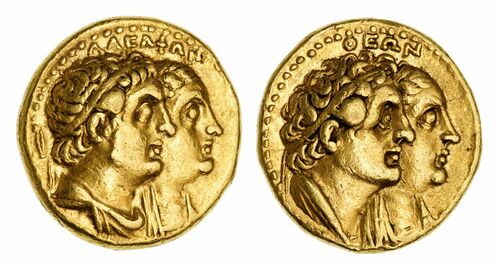Auction: 24005 - The Official Coinex Auction of Ancient, British and World Coins
Lot: 230
NGC Ch VF | Ptolemaic Kingdom of Egypt, Ptolemy II Philadelphos (284-246 BC), AV Half-Mnaieion (Tetradrachm), Alexandria, 'Theon Adelphon' type, struck after 265, ADELPHON, jugate busts of Ptolemy II, diademed and draped, and Arsinoe II, diademed and veiled, right, Galatian shield behind, rev. Jugate busts of Ptolemy I, diademed and draped, and Berenike I, diademed and veiled, right, 13.87g (CPE 314; Svoronos 604; SNG Copenhagen 133; Noeske 38; Boston MFA 2275; Dewing 2753-4), well centred, good very fine, in an NGC 'Ancients' holder, graded Choice Very Fine ~ Edge Marks (Strike: 5/5, Surface: 3/5) [NGC Cert. #8221846-007]
Provenance
The "Estafefette No. 21" Collection of Ancient, English and World Coins
Ptolemy II's gold Tetradrachm (or Half Mnaieion) coinage pays tribute both to Arsinoe and their joint rule, as well as to his parents, Ptolemy I Soter and his wife Berenike I. While Ptolemy I founded the Ptolemaic Dynasty, which would rule Egypt until the suicide of Cleopatra following the Battle of Actium in 31 BC, Ptolemy II and Arsinoe certainly established it. While their fortunes in prosecuting an aggressive foreign policy were mixed, Egypt underwent a cultural revival under their stewardship, with new building projects and an influx of Greek intellectuals. Part of this consolidation of the dynasty, as ever in the ancient world, required, in addition to these forward-thinking initiatives, a much more conservative glance backwards, to the Pharaonic era and to Ptolemy's father. His aforementioned sibling marriage to Arsinoe was a throwback to the 'sacred' marriage rituals of the old native Pharaohs, designed to win over the notoriously xenophobic Egyptians. The memorialisation of Ptolemy I and Berenike, meanwhile, accentuated Ptolemy II's links to his father and, by extension, to the beloved Alexander the Great - a reminder to the Hellenistic Greek world of his substantial pedigree.
One last group given tribute on this coin is the large community of Galatian mercenaries living in Egypt, who maintained a clear ethnic distinction within the Ptolemaic Kingdom, showcased by their unique Celtic shield, which differed from that carried by the native Egyptian troops. The Galatians (so named due their linguistic link to the inhabitants of Gaul), were a Celtic people who had long been present in the Balkans, raiding Greek cities before being employed as mercenaries in the Wars of the Diadochi. A large contingent of these mercenaries crossed the Balkans and began raids in Anatolia, eventually settling south of Bithynia, though many re-entered the employ of the various Hellenistic armies, including those of the Ptoleamic, Seleukid and Attalid Kingdoms. Relied upon heavily by Ptolemy in his wars against the Seleukid Empire, and as a neutral peacekeeping force in Egypt itself, the inclusion of the Galatian shield in the royal coinage was a clear invocation of the value these warriors of the Anatolian highland were held in by the Ptolemaic dynasty. Indeed, it is likely that the Galatians would have been the principal handlers of these coins, as native Egyptians were reluctant to use gold currency, which they viewed as a corruption of a holy material which ought to have been preserved for religious worship. This emphasis of continuity, inclusion and stability, both for the establishment of a new, foreign dynasty, and as inheritors of a native tradition revered by the Greeks for its antiquity, was borne out in Ptolemy II's considerable length of reign, which spanned thirty-eight years. He has been something of a lesser-appreciated figure, despite his major achievements as King, until recently, however his numismatic impact has long been recognised and plays a major part in Ptolemaic historiography.
Subject to 20% VAT on Buyer’s Premium. For more information please view Terms and Conditions for Buyers.
Sold for
£4,000
Starting price
£2800









